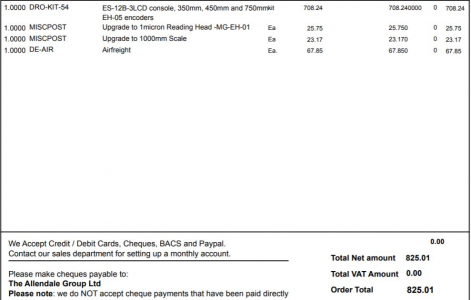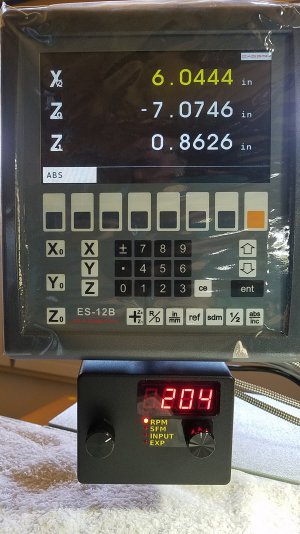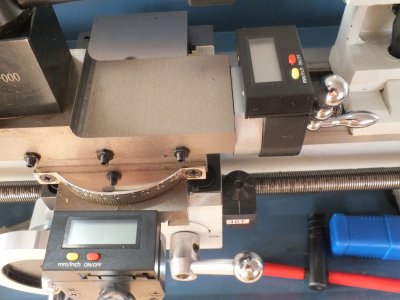-
Welcome back Guest! Did you know you can mentor other members here at H-M? If not, please check out our Relaunch of Hobby Machinist Mentoring Program!
You are using an out of date browser. It may not display this or other websites correctly.
You should upgrade or use an alternative browser.
You should upgrade or use an alternative browser.
Lathe owners with DRO’s
- Thread starter COMachinist
- Start date
- Joined
- Dec 14, 2018
- Messages
- 629
I did get the 1 micron scale for the cross slide. The kit comes with instructions on how to set the proper display resolution.Did you go with the 1 or 5um cross slide encoder? The El400 is the lathe specific read out right?
CH
And the EL400 is machine specific.
- Joined
- Feb 2, 2017
- Messages
- 1,234
Also interested in this topic. Have also heard good things about DROPros--excellent documentation and customer service at a price a couple hundred dollars more than the AliExpress DROs (where you're on your own, but have also heard good things?) Has anyone seen application of a DRO on the compound? Can DROs be programmed/calibrate with trig if the compound is at 30°?
- Joined
- Feb 1, 2015
- Messages
- 9,568
The DRO's that I have used have a scale calibration factor. I'm not sure why I would want a DRO for linear movement on the compound. I expect that it would be more of a bother than useful. There was a post a while back about reading compound angle with a DRO. That might be of more use.Also interested in this topic. Have also heard good things about DROPros--excellent documentation and customer service at a price a couple hundred dollars more than the AliExpress DROs (where you're on your own, but have also heard good things?) Has anyone seen application of a DRO on the compound? Can DROs be programmed/calibrate with trig if the compound is at 30°?
- Joined
- Mar 16, 2020
- Messages
- 157
I have only installed a handful of DRO's with stuff on the compounds. The higher end Acu-Rite boxes can compensate for X/Z movement if you input the angle of the compound and its movement. Again, I have ony put like 3 of those on. To me it seems a bit pointless.
Jon
Jon
- Joined
- Jul 31, 2020
- Messages
- 765
I work restoring antique fountain pens. The threads that hold on the caps are "three lead threads". With the compound set parallel with the ways, and a DRO on the Compound, it is easy to dial in the offset for the second and third lead of threads.
You might ask "What is a three lead thread?". As an example, you set your lead screw for 8 threads per inch, but cut to the depth for 24 threads per inch. Then you offset your single point tool towards the chuck 1/3rd of the distance of your thread spacing. Cut your new groove (which is offset from your first groove/thread. Then you offset another 1/3rd towards the chuck and cut you final groove/thread. To the naked eye, the threads look like 24 threads per inch, but in terms of rotation, it only takes 8 turns to traverse and inch. Because of the steeper angle of 8 threads per inch, most caps are secured in place with a single rotation (which is why this type of thread was so popular for the old Fountain pens). It goes without saying that you are cutting threads without the 30 degree angle which us Americans are so fond of using, but in soft pen materials (brass, gold, ebonite, celluloid), chatter is not an issue.
You might ask "What is a three lead thread?". As an example, you set your lead screw for 8 threads per inch, but cut to the depth for 24 threads per inch. Then you offset your single point tool towards the chuck 1/3rd of the distance of your thread spacing. Cut your new groove (which is offset from your first groove/thread. Then you offset another 1/3rd towards the chuck and cut you final groove/thread. To the naked eye, the threads look like 24 threads per inch, but in terms of rotation, it only takes 8 turns to traverse and inch. Because of the steeper angle of 8 threads per inch, most caps are secured in place with a single rotation (which is why this type of thread was so popular for the old Fountain pens). It goes without saying that you are cutting threads without the 30 degree angle which us Americans are so fond of using, but in soft pen materials (brass, gold, ebonite, celluloid), chatter is not an issue.
- Joined
- Nov 23, 2014
- Messages
- 2,606
I have a TPACTools.com 2-axis on my Grizzly G0709. The kit came with 5 micron scales, my install string is below. The 5 micron scale on the cross feed only gives me resolution of 0.00039", 1 micron would be a fifth of that. I've had no issues with my DRO after 4 years of use. For my use, the 5 micron has been fine. I've found when turning that the diameter of my work doesn't match the DRO after a pass anyhow. Something a spring in the tooling and work. I'll make a spring pass at the same setting or a shade deeper and get closer to the target. If I'm trying to turn to better than 0.0005", I take the final readings with a micrometer.
Would I go back to TPAC tools for another? Maybe. . . Going to a shop like DRO Pros is like going to your local hardware store with a knowledgeable salesperson. Very helpful if you have any questions on the installation and/or function. That help does come at a cost. If you are self-sufficient, you can save yourself some money by buying directly from Aliexpress or one of the other importers.
I originally bought a 4-axis DRO from TPACTools for a Jet JVM-830 mill based on a recommendation from a co-worker who bought a 2-axis unit for his Rong Fu clone from Tom at TPAC. I bought the 2-axis for the lathe a year later based on having no issues with the one on the mill. However, I probably paid an extra $100 or so than what I could have if it was purchased from overseas.
Bruce

 www.hobby-machinist.com
www.hobby-machinist.com
Would I go back to TPAC tools for another? Maybe. . . Going to a shop like DRO Pros is like going to your local hardware store with a knowledgeable salesperson. Very helpful if you have any questions on the installation and/or function. That help does come at a cost. If you are self-sufficient, you can save yourself some money by buying directly from Aliexpress or one of the other importers.
I originally bought a 4-axis DRO from TPACTools for a Jet JVM-830 mill based on a recommendation from a co-worker who bought a 2-axis unit for his Rong Fu clone from Tom at TPAC. I bought the 2-axis for the lathe a year later based on having no issues with the one on the mill. However, I probably paid an extra $100 or so than what I could have if it was purchased from overseas.
Bruce

Grizzly G0709 Lathe Dro Install
Absolutely LOVE the 4-axis DRO on my Mill, figured it was time to put one on my Grizzly G0709 14” x 40” lathe. Many options out there for DRO’s, I chose TPACTools.com. I paid a little more than I could have from some of the eBay overseas vendors ($375 delivered), but went with Tom for a few...
 www.hobby-machinist.com
www.hobby-machinist.com
Last edited:
- Joined
- Jun 12, 2014
- Messages
- 4,805
Definitely want to go 1 micron on the cross slide, otherwise in diameter mode the scale jumps in 0.0004" increments and you can get more calculation errors because of rounding. I prefer the graphical color displays if you have vision problems, I need readers all the time. You can get the Easson 12B/C from the UK with 3 magnetic scales for around $800 shipped with 3 magnetic scales. You need to contact them to specify the length of the scales and also the resolution of each scale. Since the ES-12B/C has 3 inputs, many individuals use the 3rd axis on the tailstock. Yet to see anybody put a scale on the compound. Some of the higher end DRO's will calculate the X and Z travel based on the compound angle.
 www.machine-dro.co.uk
www.machine-dro.co.uk

My Easson 12B, mine was shipped from QMT with the incorrect glass cross slide scale (5um instead of 1um) and the Xo diameter mode had quite a bit of accuracy issues, when switched to 1 um scale the calculation errors went away. Diameter mode the Xo terns yellow, but there are different color options. Z1 axis is the tailstock. I added the magnetic scale to the tailstock when I found they were available for the ES12B/C.

Universal Lathe Digital Readouts DRO Kits - Easy Fitting - Machine DRO UK
Wide Range of lathe Digital Readouts DRO Packages with Magnetic Encoders

My Easson 12B, mine was shipped from QMT with the incorrect glass cross slide scale (5um instead of 1um) and the Xo diameter mode had quite a bit of accuracy issues, when switched to 1 um scale the calculation errors went away. Diameter mode the Xo terns yellow, but there are different color options. Z1 axis is the tailstock. I added the magnetic scale to the tailstock when I found they were available for the ES12B/C.



